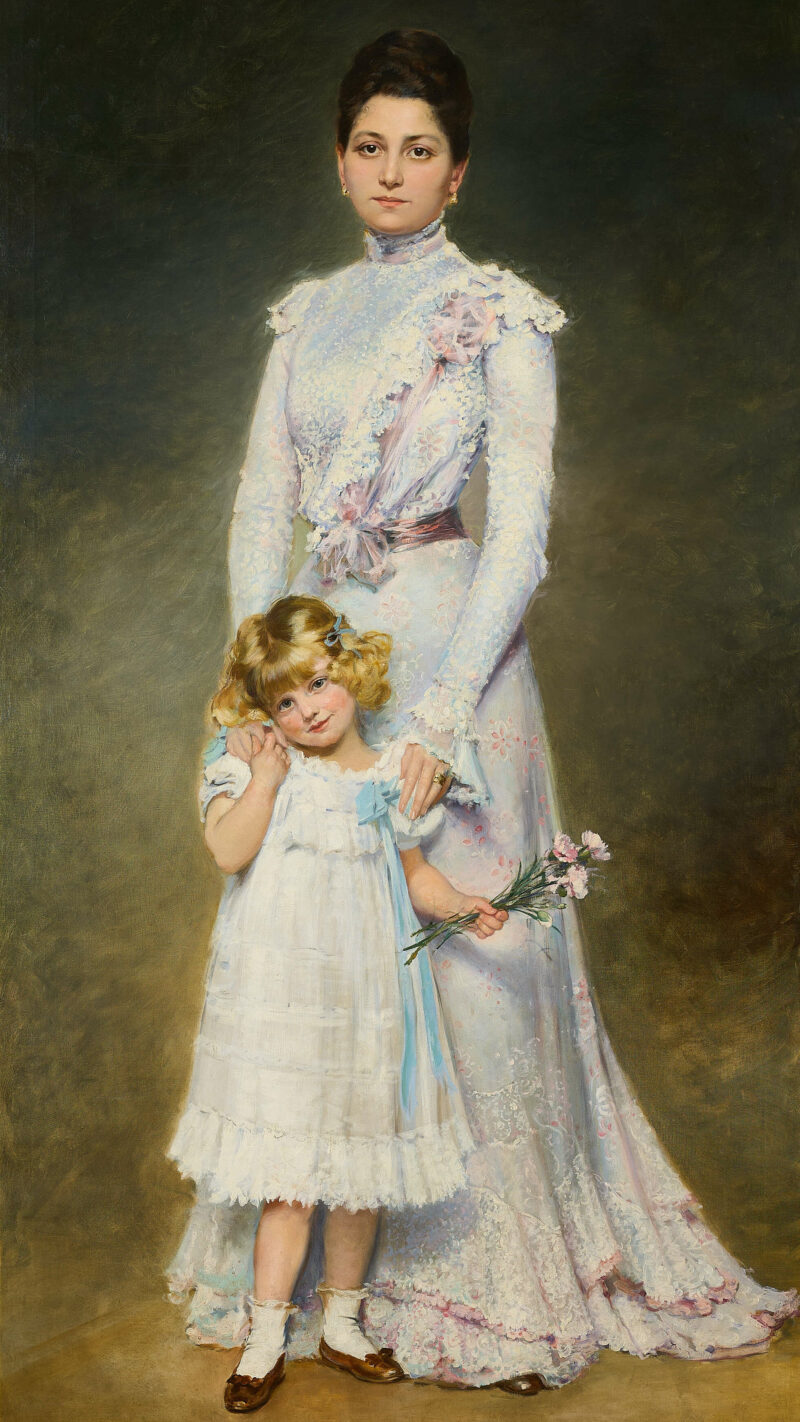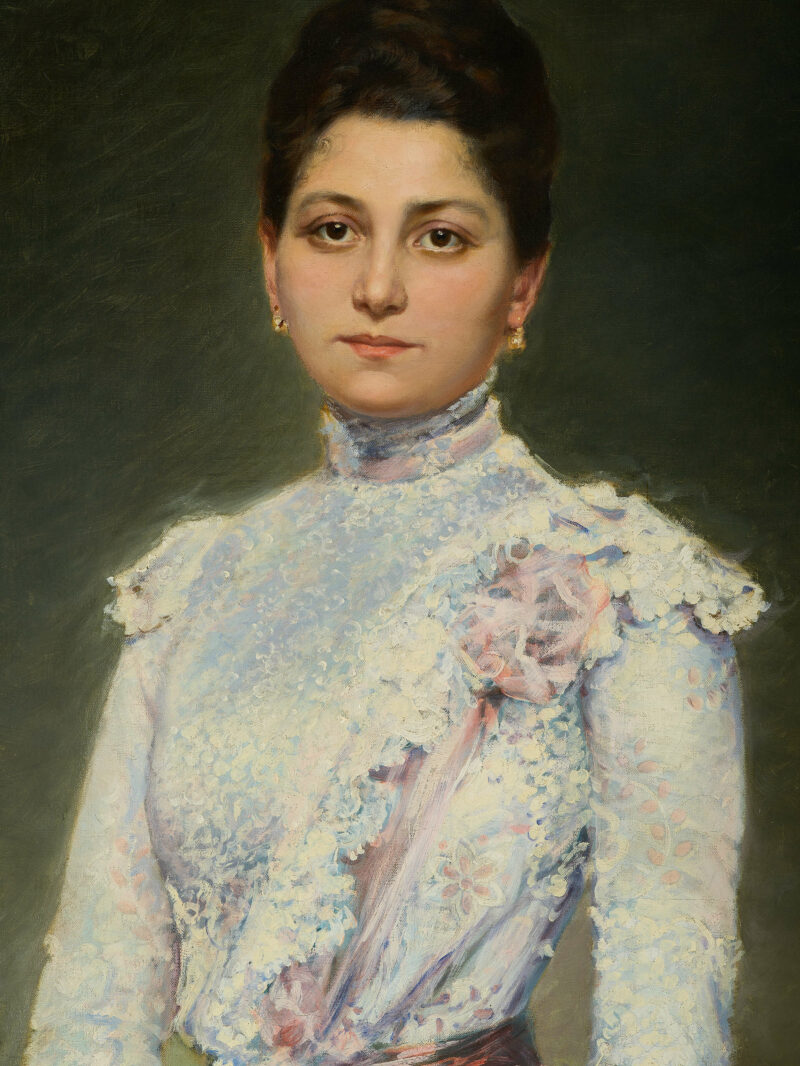
Large Oil Painting by Adolf Pirsch (Krain 1858 - 1929 Graz, Austria)
Portrait of Anna Maria Elisabeth Aloyse as a little girl, Countess Chorinski, (Brno 1899 – 1988 Vienna) with her governess; oil on canvas, in the original gilded frame.
Exhibited at the III. Art Exhibition 1902 in Graz, Austria.
Reverse exhibition label of the Association of Visual Artists Styria, III. Art Exhibition 1902, in Graz.
The large full-body portrait of the young Countess Chorinski with her governess reflects the skill, attention to detail, and radiance that make many of Adolf Pirsch’s portraits so exceptional in a very special way. The incredible luminosity emitted by this particular painting immediately captivates and reflects, in a unique manner, the era of the so-called ‘Belle Époque’ in the Habsburg Empire.
Depicted and documented in: Rudi Ekkart and Claire van den Donk, ‘Aanzienlijke portretten; Adolf Pirsch (1858−1929) in Nederland’, W Books, Zwolle, 2022
Prov: Collection Hans Miedler Fine Art
Adolf Raimund Julius Pirsch (*July 4, 1858 in Gradac, White Carniola, Austrian Empire; † April 28, 1929 in Graz)
Adolf Pirsch was born in 1858 in Gradac in White Carniola, where his father worked in the ironworks of Franz Ritter von Friedau. At the age of 16, he moved to Graz and attended the Landscape Drawing Academy there from 1874 to 1879. His artistic path then took him to Vienna, Venice, Dresden, London, Paris, Czech Republic, Belgium, and through the Netherlands shortly before his death, back to Graz. He spent many years abroad, including 14 years in England, and settled in Haarlem for a few years after World War I.
After initial attempts in genre painting, he dedicated himself entirely to portraiture and achieved remarkable quality in it. Among others, he portrayed Pope Leo XIII, Emperor Franz Joseph I, and numerous other members of the European aristocratic society of the time. From his early years of creation, we find an altarpiece in the Church of the Brothers of Mercy from the year 1887.
An important period for Adolf Pirsch as a portrait painter was his time in the Netherlands in the early 20th century. Preceding Pirsch in the Netherlands were two painters also from the Habsburg Empire, Jean Baptiste Discart (1855−1940) and Philip de Làszlò (1869 ‑1937).
However, the foreign contribution to Dutch portrait art was not limited to Pirsch, Discart, and De László, as other foreigners found their way to the Netherlands, such as the Hungarian Oscar Mendlik, who worked there from 1900 but would gain popularity somewhat later. Also worth mentioning is the Austrian Armin Horovitz, who worked regularly for the van Aldenburg Bentinek family from 1903 to 1920. It is striking that these artists also originated from the Austro-Hungarian Empire, which until the end of World War I also included areas of the Balkans and northern Italy. Together with some local painters, these Austrians shaped the image of societal portrait art in the Netherlands in the first decades of the twentieth century. Among the Dutch painters who contributed to this image were, among others, Antoon van Welie, Willem Maris Jbzn, and Han van Meegeren.
In 1900, Pirsch, commissioned by the Mayor of Vienna, created a portrait of Pope Leo XIII for the Vienna City Hall, of which at least a second painting was made for the Pope, and for which Pirsch received the Order of Gregory from the Pope. In the same year, Pirsch was commissioned by Count Grundacker von Wurmbrand with a portrait of Emperor Franz Joseph, of which there are also several versions (literature ‘Aanzienlijke portretten; Adolf Pirsch (1858−1929) in Nederland p. 19 fig. 11), see references below. In 1906, Pirsch also created a group portrait of the children of Archduke Franz Ferdinand.
From 1906, Pirsch worked for the court of the King of Saxony, was active in the English and Dutch markets from that time, and in 1913, due to a love affair with the Dutch artist Hanna Fieke, from which a daughter emerged, he also worked in Paris.
Adolf Pirsch, 70 years old, returned to his hometown Graz in 1929 where he passed away on April 28. His artistic estate went to his unmarried sister, who settled it amicably with Adolf Pirsch’s two daughters, both born out of unmarried relationships.
Significant works by Adolf Pirsch can be found, among others, in the Museum Van Loon Amsterdam, Neue Galerie Graz, Royal Picture Gallery The Hague, Foundation Family Kasteel Rechteren Limpurg, Schloss Amerongen, as well as in many private collections.
Literature/Reference:
- Rudi Ekkart and Claire van den Donk, ‘Aanzienlijke portretten; Adolf Pirsch (1858−1929) in Nederland’, W Books, Zwolle, 2022
Exhibition ‘Aanzienlijke portretten – Adolf Pirsch in Nederland’ at the Museum Van Loon, Amsterdam, April 8 — June 12, 2022, please see images below *
- Theo P.G. Kralt, The portrait painters Adolf Pirsch (1858 – 1929), Sir Philip Alexius de László (1869 – 1937), and Jean Baptiste Discart (1855 – 1940) compared. Exhibition Considerable portraits. Adolf Pirsch (1858 – 1929) in the Netherlands at Museum Van Loon in Amsterdam, Aristocracy in the Netherlands, April 13, 2022
- Holaus, Bärbel (ed.)/ Hülmbauer, Elisabeth (ed.)/ Wöhrer, Claudia (ed.): Art of the 19th century. Inventory catalog of the Austrian Gallery of the 19th century, Vol. 3: L – R, edited by the Austrian Gallery Belvedere, Vienna 1998, p.193









